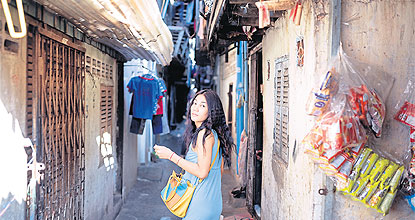At a New Year's party at CentralWorld, Soopakorn Srisakul took a picture of his friend as she lifted her arm, revealing a tear in her old black tank top. He wanted to frame her tight-fisted nature — her unwillingness to buy a new shirt — but he unintentionally captured something else: the resulting scar from breast implants that peeked through the hole. Soopakorn's arm also appears in the photograph, pushing her hand and hair aside to reveal a secret.

His series "Ms. Match" is now on show at Soy Sauce Factory. Curated by Dhanainun Dhanarachwattana, it was conceived after Soopakorn participated in a photography workshop at Bangkok Art and Culture Centre, part of the 2013 "La Fete" programme. Photographer Francois Huguier had instructed the participants to capture Bangkok for a foreign audience.
To do that, Soopakorn turned to his own world. He was seeing a katoey who was a call girl. He went to bars in Nana. His photographs are revelatory of his world, where the exotic and the pedestrian seamlessly coexist.
Before this, Soopakorn had studied architecture in college. He later began taking photographs for Ban Lae Suan (Home And Garden) magazine, which has been his full-time job for the past 10 years.
"There's definitely a special way of seeing and sensing space, more than the mere composition of photos," he says.
In one of the series' photographs, Soopakorn stands on the balcony, out of frame, as his ex-girlfriend sits on the ground inside. Partially hidden by the curtain, she turns her head toward the half-opened door to blow out smoke. The door frame, the wall, the square-tiled floor — factors culminating in a spontaneous moment of frozen, but perfectly curated, time.
Soopakorn's work emerges at a time when Instagram and other facets of social media have allowed for the domination of the snapshot aesthetic, more than 30 years after Nan Goldin invented a new language of photography through the obsessive chronicling of her life and the lives of those around her. Yet Soopakorn's work is refreshing in its sincerity. Despite its disclosure of the lives of transgenders, it is not purposefully edgy. Rather, it is tender and intimate, without pretension.
"Yes, I know of Nan Goldin. [Photographer Miti Ruangkritya] found me on Flickr, and we became friends. I took photographs at his wedding and he gave me a Nan Goldin photobook as a gift," he says. "But no, I didn't realise how my work would be seen as personal until my friends saw it."
Soopakorn is reserved and casually open at the same time — he doesn't say much, but neither does he hold back on details.
"There's a trick to it. The camera helps me get to people. When I'm at a bar, I ask to take a picture of someone, and if the picture comes out well, we can connect through Facebook or something," he says, revealing his subtle, unspoken pickup line.
"Once, I took a picture of this girl, and later she told me she would be coming back to Bangkok the next month to get a sex-change operation and asked if she could call me then."
The photographs in the series reveal that world.
"There are so many people who have photographed sex workers and ladyboys. Many of them are hardcore, like photos of the prostitutes having sex. But I think my photos are softer. I wanted to create something different, but I just followed my instinct."
The workshop with Huguier taught him how to assemble the series to convey a story. The photos in the exhibition are arranged into groups. Entering the gallery's second floor, visitors are presented with a series of explicit photographs of transgender women. In one, a woman lies on a bed, her buttocks exposed, the flesh dotted with bruises.
"She has Aids," Soopakorn explains. "I've known her for five or six years. She was a hairdresser, but she didn't make enough money so she returned to [Bangkok from] Chiang Mai and became a prostitute and got sick. I asked to take photos of her and she said sure — if I paid her. None of those came out well. Later I was in Chiang Mai for work and I asked her to come over, since I was staying at a place with air conditioning and hot water. I took the photos after she fell asleep. I showed them to her and she was like, 'OK, give me more money'."
The affection he shares with his subjects surfaces in small details. In this particular photograph a phone is being charged in a corner, offering a strange sense of domesticity and comfort. Soopakorn also captured the rear ends of two transgender women, as they look in a mirror moments after having their hips injected with silicone. He photographed his ex-girlfriend asleep, at work, at home upcountry, raising her hand at a buffalo.
He photographed her wearing make-up and false lashes.
He photographed his own wallet, which contained her mugshot.
Through his lens, his subjects, heretofore enigmatic, are revealed as people recreating their own identities, making public the manifestation of their fantasies.
'Ms. Match' is on exhibition at Soy Sauce Factory (Charoen Krung 24) until Feb 7.



